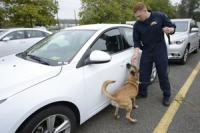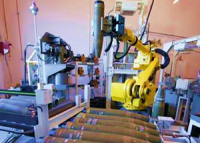-
Protection against Terrorist Attacks with Homemade Explosives
Terrorist attacks often feature the use of homemade explosives. For the police and security forces to be able to take appropriate precautions and assess the damage after an attack, they need access to the right kind of tools. Researchers have now developed a sophisticated risk-analysis system to help prevent such attacks. At the same time, the software-based system assists with the forensic investigation of such incidents.
-
-
Preparing for an Explosive Attack
Explosives are a popular choice among terrorists for causing disruption, casualties and destruction. Although chemical, biological, radiological and nuclear (CBRN) weapons may cause much more damage, explosives can still be the first choice because they are relatively easy to make, transport and use. DHS S&T says it wants to make sure that state and local leaders have choices, too, by arming them with technology to plan for worst-case scenarios and mitigate the fallout of terrorist attacks.
-
-
Water Cannon Technology Disarms IEDs
Improvised explosive devices (IEDs) are a constant and ever-changing threat to the security of our nation. Their extreme destructive potential demands innovative solutions. That’s where the Reverse Velocity Jet Tamper (ReVJeT) comes in. ReVJeT breaks apart IEDs by targeting a stream of high-velocity liquid, such as water. It does not detonate the device, but rather disarms it from a distance and allows bomb technicians do their jobs faster, safer, and more effectively.
-
-
Intelligent Camera Detects Roadside Bombs Automatically
Roadside bombs are sneaky and effective killers. They are easy to manufacture and hide, making it the weapon of choice for insurgents and terrorists across the world. Finding and disabling these lethal devices is difficult. Dutch engineers have developed a real-time early-warning system. When mounted on a military vehicle, it can automatically detect the presence of those bombs by registering suspicious changes in the environment.
-
-
DHS S&T Event to Host Innovators, Researchers, Experts on Canine Detection
Department of Homeland Security (DHS) Science and Technology Directorate (S&T) is inviting innovators, researchers, and canine training experts to learn about funding opportunities in the detection canine field. “We want to reach a broad spectrum of innovators to help us solve our most important detection canine research challenges,” said Don Roberts, S&T’s Detection Canine Program Manager.
-
-
Faster, Smarter Security Screening Systems
By now, attendees to sporting events, visitors to office buildings, and especially frequent fliers are all quite familiar with the technologies used at security checkpoints. You arrive at the security checkpoint, check your bags, show your ID and maybe your ticket or boarding pass, throw away the coffee or water you’ve been chugging, and then wait in a long line until it is your turn to be screened. The security lines can be inconvenient. S&T and partners are working to help security screening systems, whether at airports, government facilities, border checkpoints, or public spaces like arenas, to work faster and smarter.
-
-
Differentiating Earthquake from Underground Explosion
Sandia National Laboratories researchers, as part of a group of National Nuclear Security Administration scientists, have wrapped up years of field experiments to improve the United States’ ability to differentiate earthquakes from underground explosions, key knowledge needed to advance the nation’s monitoring and verification capabilities for detecting underground nuclear explosions.
-
-
Assessing Handheld Explosives Trace Detectors
Individuals who carry explosives or have been involved in bomb making are likely to be contaminated with trace explosives, microscopic particles invisible to the naked eye. Without the right equipment, detecting trace explosives can be challenging for responders and security personnel. Handheld explosives trace detectors (ETDs) can be used to complement bomb-sniffing canines, which are still the gold standard in trace explosives detection. These detectors can be used to find trace explosives on individuals, hopefully preventing a dangerous incident.
-
-
Shoe scanner may improve airport security
The types of shoes you wear when flying matter. And not just shoe types. Size, material, soles and heels are also very important. Why? Shoes can become dangerous vehicles for terrorists’ plots. DHS wants to prevent future incidents, and this is why S&T is working on a millimeter wave technology for screening shoes as part of the larger Screening at Speed Program.
-
-
Improving canine detection of explosives

The Department of Homeland Security (DHS) Science and Technology Directorate (S&T) has awarded $564,988 in funding to Auburn University for two research and development (R&D) projects designed to improve the effectiveness and efficiency of canines trained to detect explosives.
-
-
700,000 submunitions demilitarized by Sandia-designed robotics system

More than 700,000 Multiple Launch Rocket System submunitions have been demilitarized since the Army started using an automated nine-robot system conceptualized, built and programmed by Sandia Lab engineers. The automated system was built for the Army’s demilitarization program that aims to dismantle obsolete ammunition and missiles.
-
-
Breeding challenges of land mine-finding rats
Thousands of people – many of them children – are hurt or killed by land mines each year, so finding these devices before they explode is critical. There is a surprising champion of detection: the African giant pouched rat. Native to sub-Saharan Africa, the pouched rats are large – they can grow up to 3 feet long, including the tail – but are still too small to set off the land mines. They have an exceptional sense of smell – they are also used to detect tuberculosis – but scientists know very little about their biology or social structure, and they’re difficult to breed in captivity.
-
-
Secret Service intercepts explosive devices sent to Clintons, Obama, CNN
The U.S. Secret Service says it has intercepted two suspicious packages with “possible explosive devices,” one of them addressed to former President Barack Obama and the other to former Secretary of State Hillary Clinton. Within hours, the Time Warner Center in New York, where news network CNN has studios, was evacuated Wednesday morning after a suspicious device was found in the mail room there.
-
-
Developing new security scanners capable of detecting explosives
Using a single pixel camera and Terahertz electromagnetic waves, a team of physicists has devised a blueprint which could lead to the development of airport scanners capable of detecting explosives. The researchers have found an innovative way to capture with high accuracy, not just the shape of an object, but also its chemical composition using a special “single point” camera capable of operating at Terahertz (THz) frequencies.
-
-
WiFi can detect weapons, bombs, chemicals in bags
Ordinary WiFi can easily detect weapons, bombs and explosive chemicals in bags at museums, stadiums, theme parks, schools and other public venues, according to a new study. Researchers demonstrated how this low-cost technology could help security screening at public venues like stadiums, theme parks and schools.
-
- All
- Regional
- Water
- Biometrics
- Borders/Immig
- Business
- Cybersecurity
- Detection
- Disasters
- Government
- Infrastructure
- International
- Public health
- Public Safety
- Communication interoperabillity
- Emergency services
- Emergency medical services
- Fire
- First response
- IEDs
- Law Enforcement
- Law Enforcement Technology
- Military technology
- Nonlethal weapons
- Nuclear weapons
- Personal protection equipment
- Police
- Notification /alert systems
- Situational awareness
- Weapons systems
- Sci-Tech
- Sector Reports
- Surveillance
- Transportation
Advertising & Marketing: advertise@newswirepubs.com
Editorial: editor@newswirepubs.com
General: info@newswirepubs.com
2010-2011 © News Wire Publications, LLC News Wire Publications, LLC
220 Old Country Road | Suite 200 | Mineola | New York | 11501
Permissions and Policies
Editorial: editor@newswirepubs.com
General: info@newswirepubs.com
2010-2011 © News Wire Publications, LLC News Wire Publications, LLC
220 Old Country Road | Suite 200 | Mineola | New York | 11501
Permissions and Policies
